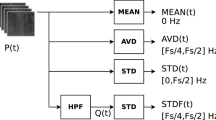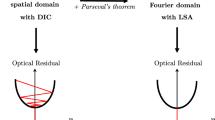Abstract
A statistical analysis of the subjective laser-speckle pattern is performed with emphasis on its spectral distribution. An optimal sampling resolution of the laser-speckle pattern is obtained using the Shannon sampling theorem. Experiments show that the displacement-only correlation using laser speckles is a reliable measurement as long as the sampling requirement is satisfied. Upper limits of measurement such as accuracy, measurable area and measurable deformation are discussed. A method of changing the measurement capabilities by adjusting the speckle-recording arrangement is also given.
Similar content being viewed by others
References
Chiang, F.P., “A new family of 2D and 3D experimental stress analysis techniques using laser speckles,”SM Archives,3 (1),27–58 (1978).
Hung, Y.Y., “Shearography: a New Optical Method for Strain Measurement and Nondestructive Testing,”Opt. Eng.,21 (3),391–395 (1982).
Peters, W.H. andRanson, W.F., “Digital Image Techniques in Experimental Stress Analysis,”Opt. Eng.,21 (3),427–431 (1982).
Peters, W.H., Ranson, W.F., Sutton, M.A., Chu, T.C. andAnderson, J., “Application of Digital Correlation Methods to Rigid Body Mechanics,”Opt. Eng.,22 (6),738–742 (1983).
Sutton, M.A., Wolters, W.J., Peters, W.H., Ranson, W.F. andMcNeill, S.R., “Determination of Displacements Using an Improved Digital Correlation Method,”Image and Vision Computing,1 (3),133–139 (1983).
Chu, T.C., Ranson, W.F., Sutton, M.A. andPeters, W.H., “Application of Digital-image-correlation Techniques to Experimental Mechanics,”Experimental Mechanics,25 (3),232–244 (1985).
Sutton, M.A., Cheng, M., Peters, W.H., Chao, Y.J. andMcNeill, S.R., “Application of an Optimized Digital Correlation Method to Planar Deformation Analysis,”Image and Vision Computing,4 (3),143–150 (1986).
Bruck, H.A., McNeill, S.R., Sutton, M.A. andPeters, W.H., “Digital Image Correlation Using Newton-Raphson Method of Partial Differential Correlation,”Experimental Mechanics,29 (3),261–267 (1989).
Hamed, M.A., “Object-motion Measurements using Pulse-echo AcousticalSpeckle and Two-dimensional Correlation,”Experimental Mechanics,27 (3),250–254 (1987).
He, Z.H., Sutton, M.A., Ranson, W.F. andPeters, W.H., “Two-dimensional Fluid-velocity Measurements by Use of Digital-speckle Correlation Techniques,”Experimental Mechanics,24 (2),117–121 (1984).
Sutton, M.A., McNeill, S.R., Jang, J. andBabai, M., “Effects of Subpixel Image Restoration on Digital Correlation Error Estimates,”Opt. Eng.,27 (10),870–877 (1988).
Rosenfeld, A. andKak, A.C., Digital Picture Processing,1,Academic Press,New York (1982).
Bailey, H.H., Blackwell, F.W., Lowery, C.L. and Ratkovic, J.A., “Image Correlation: Part I. Simulation and Analysis,” report prepared for United States Air Force Project Rand, R-2057/1-PR (Nov. 1976).
Wessely, H. W., “Image Correlation: Part II. Theoretical Basis,” report prepared for United States Air Force Project Rand, R-2057/2-PR (Nov. 1976).
Khetan, R.P. andChiang, F.P., “Strain Analysis by One-beam Laser Speckle Interferometry. 1: Single Aperture Method,”Appl. Opt.,15,(9),2205–2215 (1976).
Goodman, J.W., Introduction to Fourier Optics, McGraw-Hill, San Francisco (1968).
Yu, F.T.S., Optical Information Processing, John Wiley & Sons, New York (1983).
Harris, F.J., “Multirate FIR Filters for Interpolating and Desampling,”Handbook of Digital Signal Processing, Engineering Applications, ed. D.F. Elliott, Academic Press, New York, 173–287 (1987).
Lahart, M.J., “Optical Area Correlation with Magnification and Rotation,”J. Opt. Soc. of Amer.,60 (3),319–325 (1970).
Chen, D.J., and Chiang, F.P., “Computer Speckle Interferometry,” Proc. Int. Conf. on Hologram Interferometry and Speckle Metrology, 49–58 (1990).
Chen, D.J. and Chiang, F.P., “Optimal Sampling Resolution and Range of Measurement in Digital Speckle Correlation: Part I. Laser Speckle Method,” Proc. 1989 SEM Spring Conf. on Exp. Mech., 133–138 (1989).
Author information
Authors and Affiliations
Rights and permissions
About this article
Cite this article
Chen, D.J., Chiang, F.P. Optimal sampling and range of measurement in displacement-only laser-speckle correlation. Experimental Mechanics 32, 145–153 (1992). https://doi.org/10.1007/BF02324726
Received:
Revised:
Issue Date:
DOI: https://doi.org/10.1007/BF02324726




